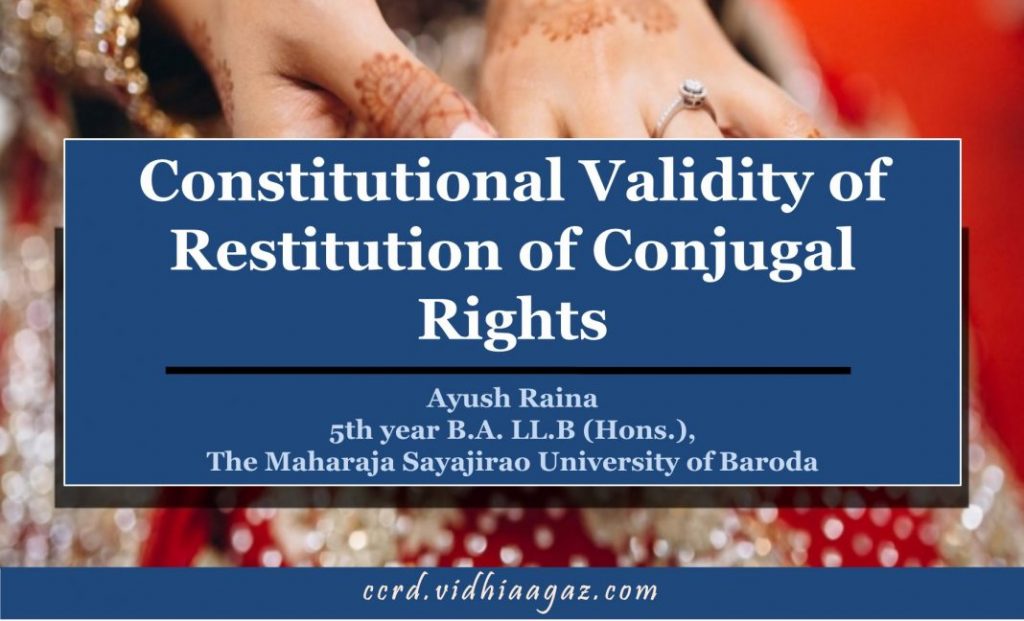Abstract
A remedy that essentially restores one’s marital rights to which he or she is entitled through marriage or marital bond. There have been repeated debates on the constitutional validity of this provision. Furthermore, it was asserted that the provision violated the Right to Equality. Thus, Section 9 of the Hindu Marriage Act was declared to be in violation of Article 14 and 21 of the Constitution of India by the Hon’ble Andhra Pradesh Court. Subsequently, the question was put forth again before the Delhi High Court and Supreme Court of India who stated that the aim was to create “co-existence” between spouses and therefore, it was only focused on “consortium”. However, what may not have been realized by the Supreme Court and the Delhi High Court is that marital rape is still legal in India. Simultaneously, it can also be said that these regulations do not hold weight more with the evolving times and cause more damage than good. However, that while England, the country from whom we borrowed the concept has abolished this remedy but whether we should be going on the same lines is open to further debate and analysis.
Keywords: Restitution of Conjugal Rights, Constitution, Equality, Fundamental Rights.
Introduction
Marriage is a holy bond where marriage is essential to ensure the coexistence of sides. Each wife has the right to the other’s consortium for convenience. It is a lifelong bond in which the parties commit themselves to live in unity for all time. Every party is entitled to receive from each other certain privileges. There is, therefore, a codification of certain legislation as a Hindu Marriage Act of 1955 in order to ensure that these rights are common. Thus, it is a remedy.
A. Meaning
Husband and wife, both are bound by law to keep their married life together and are entitled to the enjoyment of rights and obligation of duties following their solemnization of marriage. The aggravated spouse may obtain a matrimonial relief guarantee under personal laws if either spouse departs from the other so that he or she can restore his or her status to the other person subject to validation of certain facts. This can be achieved by filing a petition before the tribunal to re-establish coexistence. This right is called Conjugal Rights. These rights can be referred to as “common law.” In principle, the term conjugal means ‘wedlock’.
If either spouse or spouse have withdrawn from society without adequate excuse, the aggravated group may request a refund of marriage privileges and the court, by a request to the district court, and the Court, be satisfied by the reality of the statements made in such request, and there is no lawful reason why the request should not be awarded, may restore the order.
The request for restitution of conjugal rights cannot be maintained since no legal relationship exists. It is up to the individual who has left society to provide a good reason why he/she had withdrawn from society[1].
Explanation: Where the issue arises as to whether the withdrawal from society is rational, it is the responsibility of the individual who has withdrawn from the community to prove a decent excuse.[2] In most instances, the issue occurs as to the constitutionality of this clause itself.
Essentials:
- Withdrawal from the community.
- The withdrawal shall be without rational cause, excuse or legitimate reason.
- No other legal grounds for denying relief should exist.
- The court must be satisfied with the reality of the statement made in the petition.
It is a remedy to avoid separation in marriage and is a favorable solution requiring the coexistence of both sides to marriage.
Constitutionality of Restitution of Conjugal Rights
The issue of the constitutional validity of Section 9 was first raised in T Sareeta v Venkatasubbiah,[3] in which the Andhra Pradesh High Court held Section 9 of the Hindu Marriage Act to be violative of the Constitution and the impugned section was unconstitutional.
Justice Chaudhary held Section 9 to be “savage and barbarous remedy violating the right to privacy and human dignity guaranteed by Article 21 of the Constitution, hence void.”[4]
Justice Chaudhary traced the history and effectiveness of the remedy in providing the judgment and observed that: “Section 9 promotes no legitimate purpose based on any conception of the general good. It does not sub-serve any social good”.[5]
The dictum of Justice Chaudhary did not find favor with the Delhi High Court when it was questioned in Harvinder Kaur v Harminder Singh.[6] Justice Rohtagi observed “Justice Chaudhary in the case of T. Sareetha has over-relied on sex is the basic fallacy in his opinion. As per J. Rohtagi, J. Chaudhary only seems to suggest that restitution of conjugal rights order has only a maiden purpose, that is, to force the disinclined wife to enter into sexual intercourse with her husband.”[7]
The matter then finally came before the Supreme Court in Saroj Rani v Sudarshan Kumar Chadha[8] where the Supreme Court overruled T Sareeta[9] relying on the judgment of Justice Rotagi in Harvinder Kaur. Justice Sabyasachi Mukarji observed that “it cannot be viewed in the manner the learned single Judge bench of the Andhra Pradesh High Court has viewed it and we are unable to hold that S.9 to be violative of Article 14 and Article 21 of the Constitution.”[10] The judgment was held in favor of Section 9 of the Hindu Marriage Act of 1955, in the legal sphere as declared by the apex court and, most of all, the principle of restitution of conjugal rights stands constitutional in the Indian legal system.
With regard to the violation of Article 14 of the Constitution, the Court ruled that there is complete equality of both genders and equal safeguard of the laws so far as the relief is concerned, thus, Section 9 could not be held to be in violation of Article 14 of the Constitution because by the amending Act 44 of 1964 “either party to a marriage” is allowed to present a petition on the ground given in Section 13 (I-A).
With regard to the violation of Article 21 of the Constitution, the Court observed that the only purpose of the remedy is ‘cohabitation’ and it is not enforcing sexual intercourse between the unwilling spouse. The court denounced the introduction of Constitutional Law into family law since it will prove a ruthless destructor of the institution of marriage.
The aim of the Restitution Decree was only to encourage a united marriage and to prevent an unwilling woman from engaging in sexual intercourse with the husband. The only objective was to achieve ‘cohabitation’ between spouses, and therefore, ‘consortium’ was only concentrated.
However, it was perhaps not realized by the Supreme Court and the Delhi High Court that marital rape was legal in India. The husband can very well force his wife to enter into sexual relationships without implications, except with a long-drawn-out petition for divorce based on cruelty or a petition for domestic violence based on sexual violence. In fact, the decree efficiently puts a wife under the pressure of forceful sex with her husband and in the course of this process also strips her of physical autonomy, dignity, and the basic freedom to make her own choices relating to her own life and body, by submitting an unwilled wife to “forced cohabitation” and “consortium.”
A. Article 14 of the Constitution
Both husband and wife can access a remedy for the Restitution of Conjugal Rights while considering the remedy from a socio-legal perspective, the inherent differences between a man and a woman cannot be ignored. A remedy is not enough available to be applied in society, we should not overlook the fact that most women still enjoy a comparatively low social and financial position in society as compared to men.
Restitution of conjugal rights violates the right to equality and right to life. Equality implies equality of thought, actions, and self-realization. The continuation of the remedy leads to unwanted pregnancies and argues that it violates the feeling of respect for themselves, dignity and personal satisfaction of women.
The remedy for the Restitution of Conjugal Rights violates the very nature of a person by dictating his choice as to who to live with. Both married couples are not always equivalent and the wife is mostly–socially and economically–dependent on the husband in our extremely patriarchal Countries.
In the man-dominated society, the advantages of different laws and remedies are usually reaped by men because of ignorance, economic dependence, and other factors. There is only an obvious quality because in the majority of instances the wife is put in an unfavorable situation.
B. Article 21 (Right to Privacy) of the Constitution
The right to privacy (Article 21 of the Constitution), is not expressly guaranteed in the Constitution. Privacy has no fixed definition.
The first case of the right to privacy in Supreme Court was the case of Kharak Singh v State of UP[11] Justice Subba Rao said: “any definition of the right to privacy must encompass and protect the personal intimacies of the home, family, marriage, motherhood, procreation, and child-rearing.”[12]
In Govind v State of MP,[13] the Court established that right to privacy is a fundamental right, but like its American counterpart, it was included in the liberty clause. Justice Mathew observed that “any right to privacy must compass and protect the personal intimacies of the home, the family, marriage, motherhood, procreation, and child-rearing.”[14]
It is a natural necessity for a person to set individual limits and limit the entry of others into this sector. Privacy is very hard to describe as a right which is still undefined in contours. It is not a unity notion but it is more sensitive to enumeration than the definition in multi-dimensional terms.
CONCLUSION
A. Analysis: Why should it be abolished?
- Deception by the Petitioner:
Reconciliation between the husband and wife to save their marriage is the primary reason for the restitution of conjugal rights. However, when filing for the same, individuals often have other ulterior motives. In addition, section 13 (1-A) of the Hindu Marriage Act, 1955 states that it can be used as a ground for divorce if it is not complied with. This defeats Section 9’s own purpose as its purpose is to prevent divorce.
2. Difficulties in the enforcement of the decree:
If an individual fails to comply, the Court may implement the decree.[15] Under Rule 32(1), the Court may attach the decree holder’s property by selling their property within 6 months. However, when the wife does not own property, which is very prevalent in India, this becomes an issue. Then there is a method to determine her share of the estate of her husband.
3. Interference by the Court:
Marriage is a bond of emotions. The withdrawing spouse’s will is not taken into account. If all this is accomplished by force, how will any love and affection be brought about that a marriage should have?
In every civilized society, the institution of marriage is very important. The institution is both accepted and respected. There has been no establishment that is more enduring than marriage. While marriage is a private union among men and women, it also has a social dimension. No matter what the form of marriage may be, the stability of marital ties is always the focus.
The remedy is a borrowed idea from England to restore conjugal rights. It was launched via the British Raj. All the developments in the idea of English law were taken into consideration. However, under Section 20 of the Matrimonial Procedure Act of 1970, the remedy was abolished in England. However, the earlier the better for Indian society to eliminate this illogical provision rather than move towards a stultifying decree.
Restitution of Conjugal Rights is based on a noble cause but has lost its importance with the evolving times and social scenarios and does not produce the required impact.
The cases of abuse and redundancy are growing quickly. In spite of the judgment of the Supreme Court, the provision violates Article 14, 19 and 21 of the Constitution. Such a provision that is incompatible with changing times is detrimental and obsolete, should be eliminated. The remedy should be removed, the noble cause behind it should no longer be pursued.
The aim of the Restitution Decree was only to encourage a united marriage and to prevent an unwilling woman from engaging in sexual intercourse with the husband. The only objective was to achieve ‘cohabitation’ between spouses, and therefore, ‘consortium’ was only concentrated. The cohabitation means living together as husband and wife. However, taking into account that marital rape in India is not an offense, forcing a wife to live with her husband is a violation of her right to choose whether or not to have sex, since her husband may have sex with her without any legal penalty. Thus, even where section 9 of the Hindu marriage law does not render sexual relations obligatory, forcing a woman to remain in her marriage home involves putting her in the danger of marital rape and denying her independence over her own body, thereby breaking her right to privacy. The result of a restitution decree causes extreme difficulty for a female who is required to return to her marriage homes and duties, as it does for a man.
B. Analysis: Why it should stay in force?
- The true objective of the section:
Just because a section has the scope to be misconstrued, it doesn’t imply it should cease to exist. Its aim is to save one of the primary facets of marriage and resume cohabitation. There is no reason to prevent cohabitation if there is nothing wrong with the marriage and the way consent has been acquired.
Article 14 is incorrectly alleged to be in the breach: this section has become gender-neutral through the Amending Act 44 of 1964, where either party can initiate divorce proceedings under section 13(1-A). Even if, in the restitution proceedings the party is found guilty, they can file for divorce.
2. The wrongful view of abolitionists:
Restitution may be a ground for divorce if not complied within one year. The reason provided for this, however, is that a sudden break-up in a marriage should not occur. The one year specified is needed as a “cooling period” to avoid any hurried choice. Even then it offers for divorce if there is no cohabitation. It actually checks that divorce is only granted after the means to revive the marriage have been exhausted.
With regard to the problems in implementing this decree and Rule 32 of the Civil Procedure Code, 1908, marriage is also a contract in itself and the norm is the financial penalty for non-compliance with the agreement. Also, the property is connected only if the pronounced decree is completely disregarded and no other solution is applicable. There is also no weight-age argument for the husband not having assets as this is true in all other agreements as well.
Moreover, when conjugal rights are restored, it is not just sexual rights that are taken into account. In Halsbury’s Laws of England, he said that denying sexual intercourse alone does not constitute a denial of cohabitation. It is also impossible for the courts to force sexual intercourse.
Therefore, the restitution of conjugal rights is a component of the individual’s personal laws and is driven by values such as faith, tradition, and custom. A very important characteristic to emphasize in the restitution of conjugal rights is that it is a remedy intended to preserve marriage. It serves to help prevent marriage break-up, so it is a way to save the marriage. This remedy cannot be said to be completely unconstitutional. Section 9 has adequate safeguards to avoid a tyranny of marriage. In reality, by encouraging reconciliation between the parties and maintaining a marriage, it serves the social good objective. It protects society against denigration and all the years it’s been enforcing it’s played a part effectively.
Simultaneously, it can also be said that these regulations do not hold weight more with the evolving times and cause more damage than good.
From what has been written above, however, it is recognized that the notion of restitution of conjugal rights has left sufficient ambiguity as to whether it violates any of the fundamental rights guaranteed under Part III of the Constitution of India. This relies on facts and situations as they continue to change from case to case.
It is important to note, however, that while England, the country from whom we borrowed the concept has abolished this remedy but whether we should be going on the same lines is open to further debate and analysis.
[1] Ranjana Kejriwal v. Vinod Kumar Kejriwal, A.I.R. 1997 Bom 380.
[2] Hindu Marriage Act, 1955.
[3] A.I.R 1963 AP 356.
[4] Ibid at 3.
[5] Ibid at 3.
[6] A.I.R 1984 Del 66.
[7] Ibid at 6.
[8] Saroj Rani v Sudarshan Kumar Chadha, A.I.R 1984 SC 1652.
[9] Ibid at 3.
[10] Ibid at 8.
[11] A.I.R. 1963 SC 1295.
[12] Ibid at 11.
[13] A.I.R. 1975 SCR (3) 946.
[14] Ibid at 13.
[15] Civil Procedure Code, 1908.















